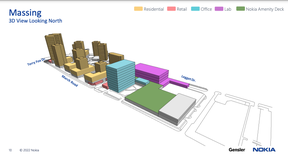Nokia’s new Kanata campus plans: retail, restaurants, housing

Assuming the plan becomes a reality, Nokia will solidify its position as the cornerstone of Kanata’s growing technology sector.
Article content
A corner of the Kanata North Technology Hub appears to be set for a dramatic makeover.
Advertising 2
Article content
Nokia, a technology infrastructure giant that employs about 2,300 people locally, is seeking city permits to build a major new campus along March Road, just south of its current location. The proposed 500,000-square-foot office and laboratory complex will include retail and commercial locations with two office towers on top. There is a parking lot for 1,344 cars.
Article content
At the same time, Nokia plans to destroy the existing office building and replace it with 11 residential towers with a height of 13-29 stories. Some of them exceed the current height limit of 144 feet. New developments include retail stores, restaurants and ample parking space for 2,410 cars. The current plan requires 1,900 homes. Nokia sites require rezoning to allow homes, retailers and restaurants.
Advertising 3
Article content
Assuming the plan becomes a reality, Nokia will solidify its position as the cornerstone of Kanata’s growing technology sector. It is also a vote of trust in the future of the office. And, in particular, adding enough housing units to accommodate more than 4,000 people will help ease some of the pressure in Kanata’s tight housing market.
The 26-acre land has witnessed many high-tech dramas since it was acquired by Newbridge Networks, a communications technology company founded by Terence Matthews in 1988. One of the region’s most successful start-ups, Newbridge has hired thousands of people around the world as revenue surged to $ 1 billion annually in the first decade (all figures are in US $). ).
Advertising 4
Article content
Succumbing to the massive needs of the industry, Newbridge sold its stake to French telecommunications equipment giant Alcatel in 2000 for $ 7 billion and later merged with Lucent Technologies of New Jersey. Even bigger deals continued in 2016 when Nokia paid out $ 17 billion in shares to buy Alcatel-Lucent. Since then, Nokia has relied on Kanata’s workforce for its expertise in optical and Internet Protocol networking technologies.
Nokia is a case study on how to navigate a turbulent industry. The Finnish tech giant in the late 1990s was the world’s number one provider of mobile phones. But when its main business was overwhelmed by the iPhone and Samsung’s Android devices, Nokia launched Plan B. It has diversified into the manufacture of rugged devices and networks that allow smartphones to communicate with each other.
Advertising 5
Article content
Nokia made $ 2 billion in revenue last year with $ 26 billion in revenue. The most profitable and fast-growing units, including the Kanata Group, will build the network infrastructure.
This makes Nokia an important part of a cluster of local technology companies building communications infrastructure around the world to support fifth-generation wireless technology. 5G software and gear provide fast and reliable connections to a wide range of electronic devices, from automobiles to appliances. Nokia, Ericsson and Siena, the three local giants, employ a total of more than 5,000 people in Kanata. They are surrounded by hundreds of other technology companies with a workforce of over 25,000 in the region.
The economic impact of this technology hub was evident in the latest census. Kanata’s population increased by 16% between 2016 and 2021. This is twice as much as the entire region. The area south and northwest of Kanata has been crowded with construction workers for most of the last decade to accommodate new homebuyers.
Advertising 6
Article content
Employment and housing construction exacerbated traffic congestion. In fact, employees of supply chain software company Kinaxis resolved before the pandemic to place a new office facility in South Kanata instead of the more crowded North Kanata Tech Hub.
This is another selling point for Nokia’s new housing unit, assuming workers return to the office. Do they do so? That is certainly the underlying assumption of Nokia’s plan. Years may pass before the proposed new campus is ready to be occupied, and the world can be a very different place.
Of course, timing can be affected by the severity of the ongoing stock market crisis and whether it is a precursor to a slowdown or contraction. Carriers such as Telus and BellCanada are expected to invest in 5G technology over the next few years, but the pace of spending depends on how quickly subscribers and businesses buy related services.
Technology companies with a long history know how quickly things change. In 1997, as Kanata’s workforce in Newbridge exceeded 2,800, the company announced plans to build several new office towers to accommodate even more jobs. After all, the company was already nearing its peak.
Despite the need to adapt to a range of new owners, Kanata Core prospered to remain competitive. Last year, it spun off nearly $ 1 billion in economic activity based on Nokia’s contribution to global production. That’s why Nokia is returning support with new bargains.

Nokia’s new Kanata campus plans: retail, restaurants, housing
Source link Nokia’s new Kanata campus plans: retail, restaurants, housing




